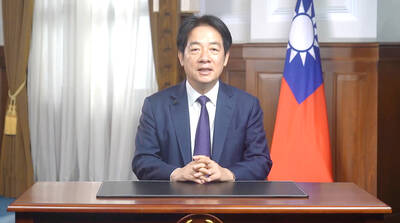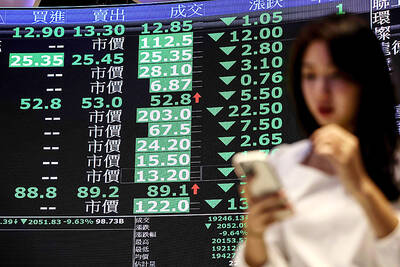Oil prices succumbed to profit-taking and a stronger US dollar on Friday at the end of a week of gains that saw prices peak above US$73 a barrel.
New York’s main futures contract, light sweet crude for delivery in July, fell to US$72.04 a barrel, a drop of US$0.64 from Thursday’s close. In London, Brent North Sea crude for July delivery shed US$0.87 to settle at US$70.92 a barrel.
“The market probably went up a little bit too quickly and I suspect we see some profit taking,” Bart Melek of BMO Capital Markets said.
The New York contract had spiked about US$5 over the past three days, peaking at US$73.23 in intraday trading on Thursday, its highest level since last October.
On May 1, the price hovered around US$50 a barrel.
Ellis Eckland, an independent analyst, said that a firmer US dollar made dollar-priced oil more expensive for buyers using weaker currencies.
“Basically you can explain the whole move with the stronger dollar and the stock equities off a little bit,” he said.
The dollar’s recent weakness against most major currencies had supported the oil rally, as had several reports indicating a pickup in weak energy demand.
The market shrugged off an OPEC report suggesting that the worst of the impact from the global economic and financial crisis was past for the oil markets, as it fractionally reduced its demand estimate for this year.
PRECIOUS METALS: Gold prices slid after a recent rally toward US$1,000 an ounce.
“Gold moved lower ... following a higher US dollar,” ODL Securities analyst Marius Paun said.
By late Friday on the London Bullion Market, gold dropped to US$937.25 an ounce from US$962 a week earlier. Silver fell to US$15.07 an ounce from US$15.65.
On the London Platinum and Palladium Market, platinum slid to US$1,241 an ounce at the late fixing on Friday from US$1,275.
BASE METALS: Base metals prices struck multi-month highs for a second week running.
By Friday on the London Metal Exchange, copper for delivery in three months jumped to US$5,255 a tonne from US$5,055 a week earlier.
Three-month aluminum climbed to US$1,670 a tonne from US$1,588.
GRAINS AND SOYA: Soya and grains prices diverged.
By Friday on the Chicago Board of Trade, maize for delivery in July fell to US$4.32 a bushel from US$4.44 a week earlier.
July-dated soyabean meal — used in animal feed — increased to US$12.55 from US$12.25.

ACTION PLAN: Taiwan would expand procurement from the US and encourage more companies to invest in the US to deepen bilateral cooperation, Lai said The government would not impose reciprocal tariffs in retaliation against US levies, President William Lai (賴清德) said yesterday, as he announced five strategies to address the issue, including pledging to increase Taiwanese companies’ investments in the US. Lai has in the past few days met with administrative and national security officials, as well as representatives from various industries, to explore countermeasures after US President Donald Trump on Wednesday last week announced a 32 percent duty on Taiwanese imports. In a video released yesterday evening, Lai said that Taiwan would not retaliate against the US with higher tariffs and Taiwanese companies’ commitments to

Intelligence agents have recorded 510,000 instances of “controversial information” being spread online by the Chinese Communist Party (CCP) so far this year, the National Security Bureau (NSB) said in a report yesterday, as it warned of artificial intelligence (AI) being employed to generate destabilizing misinformation. The bureau submitted a written report to the Legislative Yuan in preparation for National Security Bureau Director-General Tsai Ming-yen’s (蔡明彥) appearance before the Foreign Affairs and National Defense Committee today. The CCP has been using cognitive warfare to divide Taiwanese society by commenting on controversial issues such as Taiwan Semiconductor Manufacturing Co’s (TSMC, 台積電) investments in the

HELPING HAND: The steering committee of the National Stabilization Fund is expected to hold a meeting to discuss how and when to utilize the fund to help buffer the sell-off The TAIEX plunged 2,065.87 points, or 9.7 percent, to close at 19,232.35 yesterday, the highest single-day percentage loss on record, as investors braced for US President Donald Trump’s tariffs after an extended holiday weekend. Amid the pessimistic atmosphere, 945 listed companies led by large-cap stocks — including Taiwan Semiconductor Manufacturing Co (TSMC, 台積電), Hon Hai Precision Industry Co (鴻海精密) and Largan Precision Co (大立光) — fell by the daily maximum of 10 percent at the close, Taiwan Stock Exchange data showed. The number of listed companies ending limit-down set a new record, the exchange said. The TAIEX plunged by daily maxiumu in just

‘COMPREHENSIVE PLAN’: Lin Chia-lung said that the government was ready to talk about a variety of issues, including investment in and purchases from the US The National Stabilization Fund (NSF) yesterday announced that it would step in to staunch stock market losses for the ninth time in the nation’s history. An NSF board meeting, originally scheduled for Monday next week, was moved to yesterday after stocks plummeted in the wake of US President Donald Trump’s announcement of 32 percent tariffs on Taiwan on Wednesday last week. Board members voted to support the stock market with the NT$500 billion (US$15.15 billion) fund, with injections of funds to begin as soon as today. The NSF in 2000 injected NT$120 billion to stabilize stocks, the most ever. The lowest amount it